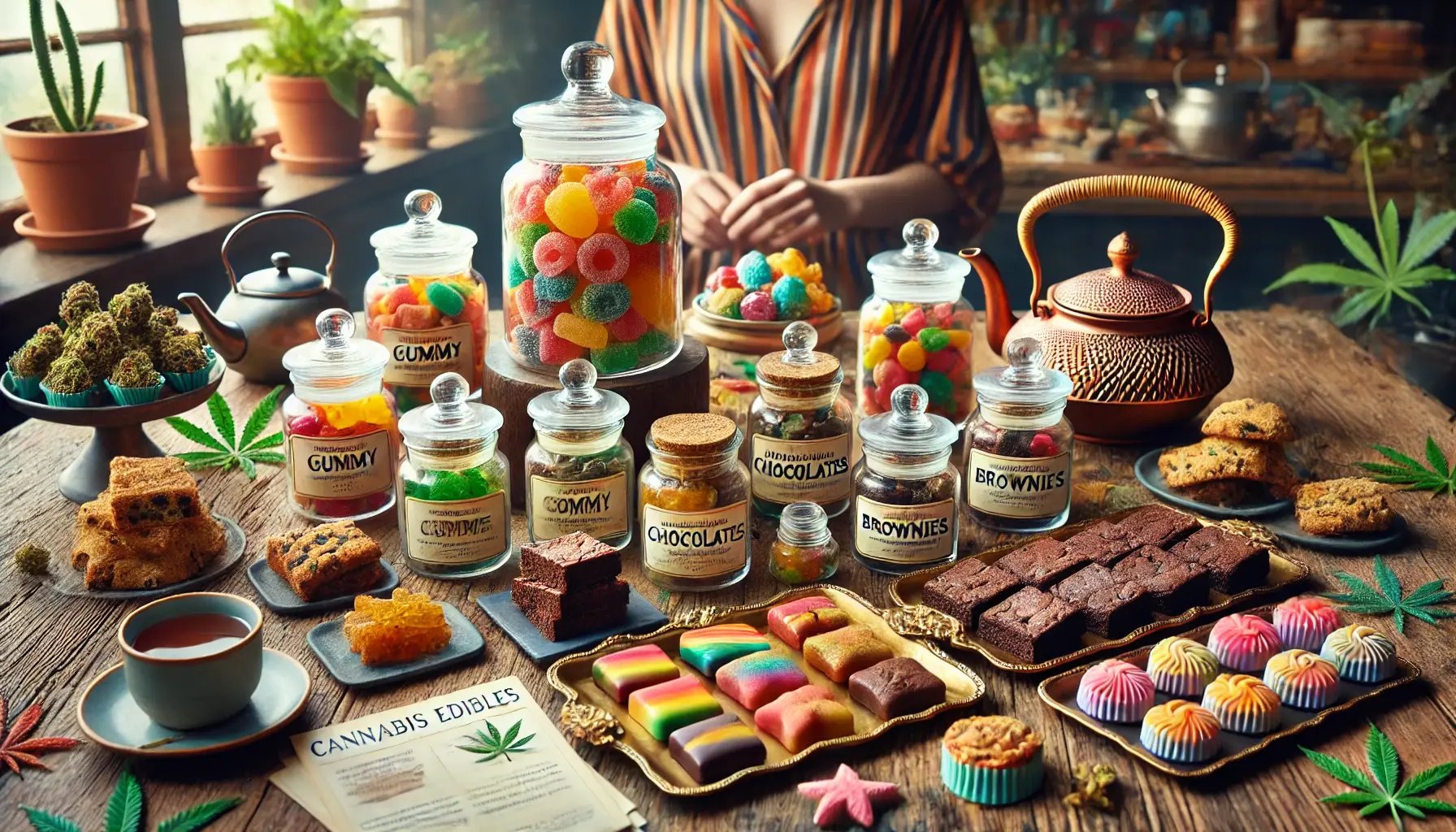
Cannabis Edibles Unwrapped: A Guide to Today's Products, Safety, and Trends
Introduction to Cannabis Edibles
Cannabis edibles—foods and beverages infused with cannabis—are increasingly popular in the market, offering a smoke-free alternative for recreational and medicinal use. These edibles come in various forms, including gummies, chocolates, beverages, and baked goods, each providing a distinct way to enjoy cannabis, catering to different preferences and offering varied effects, flavors, and benefits. Today, the market for cannabis edibles is growing, with an expanding range of products and changing consumer interests, which present both opportunities and challenges. Opportunities include expanding into niche markets, offering health-conscious products, and developing fast-acting formulations. Challenges involve ensuring consistent product quality, adhering to complex regulations, and addressing safety concerns, particularly regarding pediatric exposure.
Current Types of Cannabis Edibles
Present-day cannabis edibles have diversified well beyond the classic pot brownie. The most common forms include:
- Gummies: Popular for their portability, ease of dosing, and variety of flavors.
- Chocolates: Favored by those seeking a discreet, delicious treat that melts smoothly.

- Beverages: These include sodas, teas, and seltzers, offering a social consumption alternative.
- Baked Goods: Cookies, brownies, and cakes that provide a classic edible experience.
- Other Infused Foods: Savory snacks, candies, and even sauces to suit a wide range of tastes.
Effects and Dosage Considerations
One of the defining features of cannabis edibles is their delayed onset. Unlike inhaled cannabis, which takes effect almost immediately, edibles may take anywhere from 30 to 90 minutes to kick in. This delayed onset, combined with longer-lasting effects (up to 6-8 hours), makes edibles ideal for those who seek sustained relief from symptoms like pain or anxiety but can also lead to accidental overconsumption by inexperienced users.
Dosing Variability: The effects of cannabis edibles can be highly variable depending on factors like individual tolerance, metabolism, and the specific product used. For those new to edibles, it is best to start with a low dose and increase slowly, often referred to as the "low and slow" approach. This helps to minimize the risk of overconsumption and ensures a safer, more controlled experience.
The Science Behind Cannabis Edibles
At the core of every cannabis edible lies a crucial scientific process: decarboxylation. This essential step involves heating cannabis to 220-245°F (104-118°C) for 30-45 minutes to convert non-psychoactive THCA into active THC. Without this transformation, edibles would lack both their therapeutic and psychoactive properties, as the human body cannot efficiently process raw cannabinoid acids through digestion alone.
When consumed, THC from edibles undergoes a slower absorption process compared to inhalation, leading to delayed onset times of 30-90 minutes and generally lower peak blood THC levels. However, the effects are often longer-lasting, providing a unique experience characterized by sustained relief. This delayed onset is beneficial for users seeking extended effects but can be a challenge for new consumers who may inadvertently overconsume before feeling any initial effects.
Safety and Legal Considerations
With the rapid expansion of cannabis edibles, safety has become a primary focus. Regulations in Canada, for example, limit each package to a maximum of 10 mg THC to minimize the risks of overconsumption. In the United States, regulations vary by state, but many require child-resistant packaging, clear labeling, and warning statements to prevent unintended use.
Pediatric Safety Concerns: Brightly colored gummies and chocolates can be enticing to children, and unintentional ingestion can lead to severe health consequences, including respiratory issues and even coma. States like Colorado have taken strict measures to reduce pediatric risks, such as requiring opaque packaging and labeling that does not appeal to children.
To further enhance consumer safety, quality control has become an industry standard, with edibles undergoing rigorous testing to ensure potency verification, homogeneity, shelf stability, and contaminant screening. Good Manufacturing Practices (GMP) compliance, batch testing, and recall procedures are increasingly employed to ensure consistency and safety across all products.
Modern Consumer Trends
The edibles market is evolving rapidly, shaped by consumer demand for wellness products, innovation in dosing formats, and a desire for discreet consumption.
- Health-Conscious Options: Many consumers are looking for edibles that align with their dietary needs, such as sugar-free, gluten-free, or vegan alternatives. Products with CBD or a balanced THC-to-CBD ratio are also gaining popularity, as they provide therapeutic benefits with less intoxication.
- Fast-Acting Formulations: One of the latest innovations is the development of fast-acting edibles that reduce the onset time to 10-15 minutes. These formulations leverage nanoemulsion technology to make cannabinoids more bioavailable.
- Microdosing and Customization: Consumers are showing an increased interest in microdosing, which allows for personalized experiences without overpowering effects. This trend has led to the development of products with precise dosing, like mints and low-THC beverages.
Home-Made vs. Dispensary Options
While dispensary edibles are popular for their precise dosing and reliable effects, homemade edibles remain a favorite among DIY enthusiasts. Preparing edibles at home allows consumers to control ingredients, flavors, and potency.
To make edibles at home, decarboxylation is crucial. Without this step, the cannabinoids will not produce psychoactive effects when consumed. Infusing the activated cannabis into a fat like butter or oil forms the basis of many homemade recipes, from cookies to salad dressings.
Safety Tip: Always clearly label homemade edibles and keep them out of reach of children and pets. Homemade edibles may also vary significantly in potency, so proceed with caution.
Emerging Market Opportunities
As edibles become increasingly mainstream, targeting niche markets is becoming a prominent strategy. Non-smokers and medical cannabis patients represent significant growth opportunities, particularly those seeking alternative wellness solutions. Additionally, social users prefer edibles for gatherings, where they can consume cannabis in a non-obtrusive manner.
E-commerce and Technology Integration: E-commerce has played a major role in the expansion of edibles. Online dispensaries, blockchain tracking for product transparency, and virtual consultations are becoming the norm, providing convenience while ensuring regulatory compliance and product safety. QR codes on packaging that link to Certificates of Analysis (COAs) are popular features to build trust with consumers.
Quality Control in the Modern Market
Today's cannabis edibles undergo rigorous quality control processes that would have been unthinkable in the industry's early days. Good Manufacturing Practices (GMP) compliance, batch testing, and contamination prevention have become standard practices. Products must pass detailed examinations for potency verification, homogeneity, shelf stability, and potential contaminants before reaching consumers. These measures ensure not only consistency in dosing but also the overall safety and reliability of cannabis edibles.
Future Trends
The future of cannabis edibles is bright and innovative. With advancements in food technology, we expect to see more products focusing on functional ingredients such as adaptogens (e.g., mushrooms, herbs) alongside cannabinoids to provide specific wellness benefits like stress relief or improved sleep.
- Fast-Acting and Portable Solutions: Companies are developing products like sublingual strips, capsules, and powders that provide faster onset and easier consumption.
- Technology-Driven Transparency: Innovations like blockchain tracking, QR codes, and digital Certificates of Analysis are reshaping the consumer experience, providing transparency and building trust.
Consumer Education: The Key to Safe Consumption
As the market matures, education remains crucial. Understanding proper dosing, recognizing individual tolerance levels, and respecting onset times can mean the difference between a positive experience and an uncomfortable one. Industry leaders increasingly emphasize transparent ingredient lists, clear cannabinoid profiles, and comprehensive dosing guidelines to help consumers make informed decisions.
Main Takeaway
The world of cannabis edibles is expanding rapidly, driven by consumer demand for healthy, discreet, and reliable products. Whether you're a seasoned consumer or new to edibles, understanding the variety, dosing, and safety aspects of these products can help ensure an enjoyable and beneficial experience. As the industry continues to innovate, balancing consumer safety, quality control, and education will be key to integrating edibles into modern wellness and recreational practices effectively.